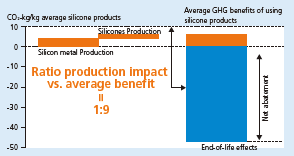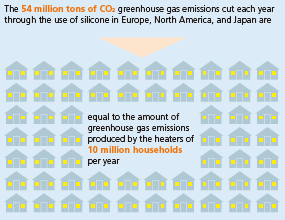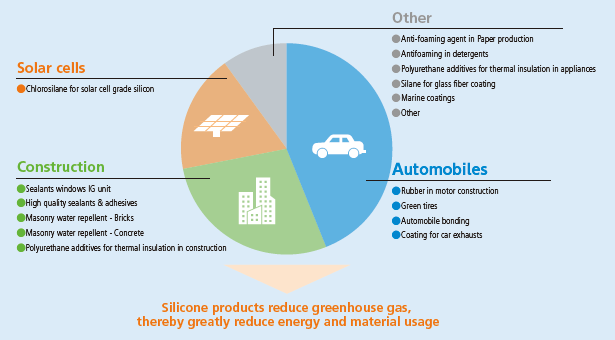Feature Article 2:Shin-Etsu Group Products and Technologies that Contribute to Environmental Conservation
Shin-Etsu Group Products and Technologies that Contribute to Environmental Conservation
The Shin-Etsu Group not only strives to reduce its environmental impact during the product manufacturing stage, but also designs product with a focus on reducing environmental impact, energy usage, and resource usage during product usage.
These products are used in a wide range of fields, including industry, daily life, and renewable energy.
Silicones
The Group produces over 5,000 silicone products, used in familiar products used in daily life, such as household products, automobiles, construction, and solar cells. While being put to each of their uses, these products are contributing to reductions in greenhouse gas emissions.
In 2012, we, together with other members of the global silicone industry, carried out a study of the entire silicone market, examining silicone greenhouse gas emissions and how much greenhouse gas emissions are curbed by the use of silicone, in comparison to silicone substitutes and alternative methods. The study found that the amount of greenhouse gas emissions eliminated through the use of silicone was 9 times greater than the amount of greenhouse gasses produced*1 by the manufacture and disposal of silicone. It also found that the use of silicone products in Europe, North America, and Japan has made it possible to reduce greenhouse gas emissions by 54 million tons of CO2 per year.*2
Silicone used in automobiles, construction, and solar cells account for the greatest share of overall silicone greenhouse gas emissions reductions. Silicone is contributing significantly to improved sustainability.
-
*1 Greenhouse Gas Reduction Effects

-
*2 Examples of Greenhouse Gas Reductions

Fields in Which Silicone Use is Reducing Greenhouse Gas Emissions, and Major Silicone Uses

- Source: Silicone Industry Association of Japan “Silicone-Chemistry Carbon Balance”
Polyvinyl Chloride
Polyvinyl chloride (PVC) is a general purpose resin that is less dependent than other types of resin on petroleum resources, being composed, by weight, of roughly 40% petroleum and 60% chlorine, which is found in abundance on earth. Its production has less environmental impact than other types of resin, and the production process uses only around 60% of the energy used to produce other general purpose resins. It is highly durable and easily recyclable, leading to its widespread use in construction materials such as PVC windows and water and sewage pipework.
PVC windows have superior insulation properties, and are resistant to fogging, making them mainstays in developed nations in Europe and North America. Their use is also accelerating in China. In Japan, as well, they are popular in mainly cold regions. Compared to ductile cast-iron pipes*1, PVC pipes have lower total carbon-dioxide emissions*2 over their lifecycles, contributing to the prevention of global warming.
- *1 Ductile cast-iron pipe
Pipes made of spheroidal graphite and iron. - *2 Lifecycle carbon-dioxide emissions
Total carbon dioxide emissions for a product, from the gathering of raw materials, through the production, use, disposal, and recycling stages.
- Source:Japan Chemical Industry Association “Lifecycle Analysis of Chemical Products in Japan and around the World”, third edition Vinyl Environmental Council website “Living with PVC Windows”
Rare Earth Magnets
Rare-earth magnets are roughly 10 times as strong as conventional ferrite magnets, offering a great deal of magnetic force despite their compact size. These properties allow them to contribute to making motors for hybrid and electric vehicles, energy saving air conditioning compressor motors, and the like more compact, lightweight, and high powered.
For example, using rare-earth magnets in air conditioning compressors can improve energy efficiency by 5 to 10%. This cuts overall power usage, helping to reduce carbon-dioxide emissions. Rare-earth magnets are also used in wind power generation motors, contributing to the field of renewable energy.



